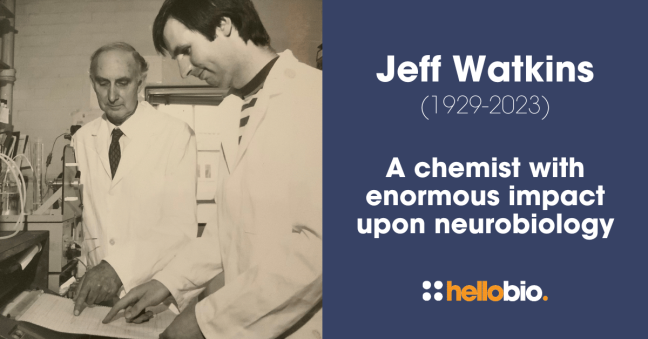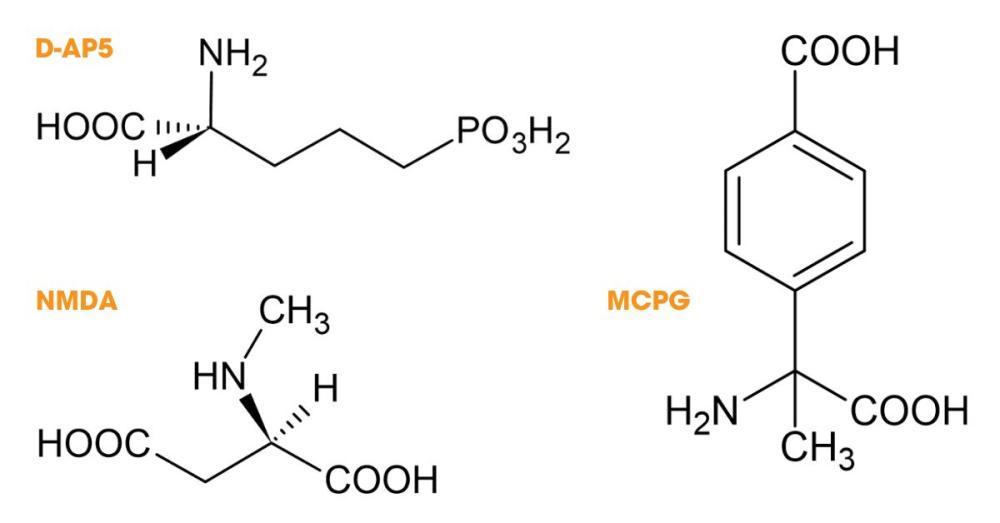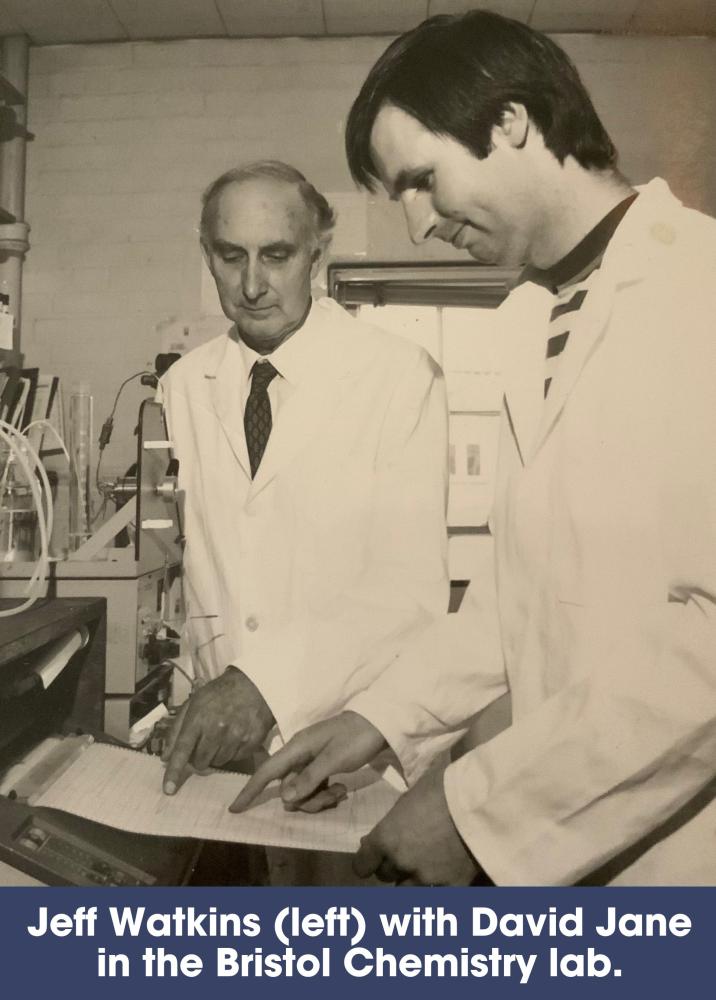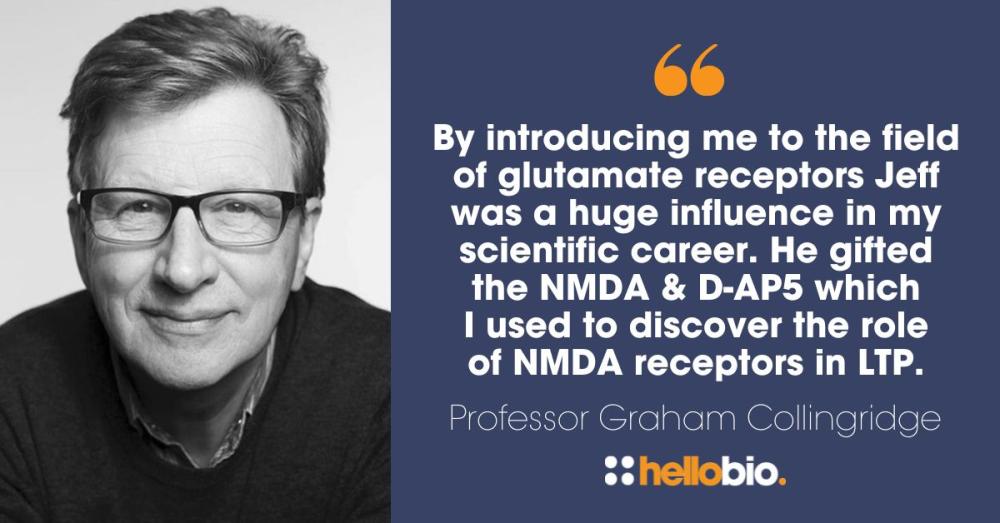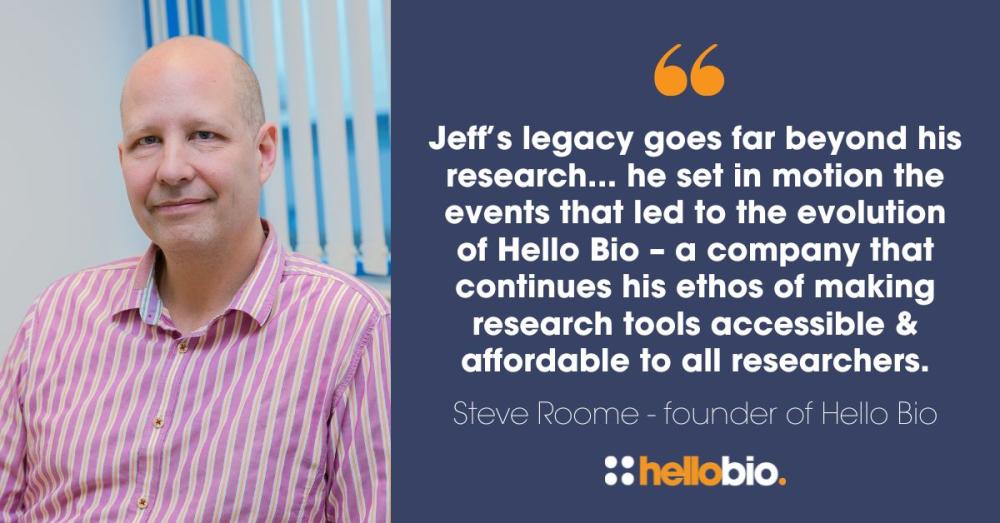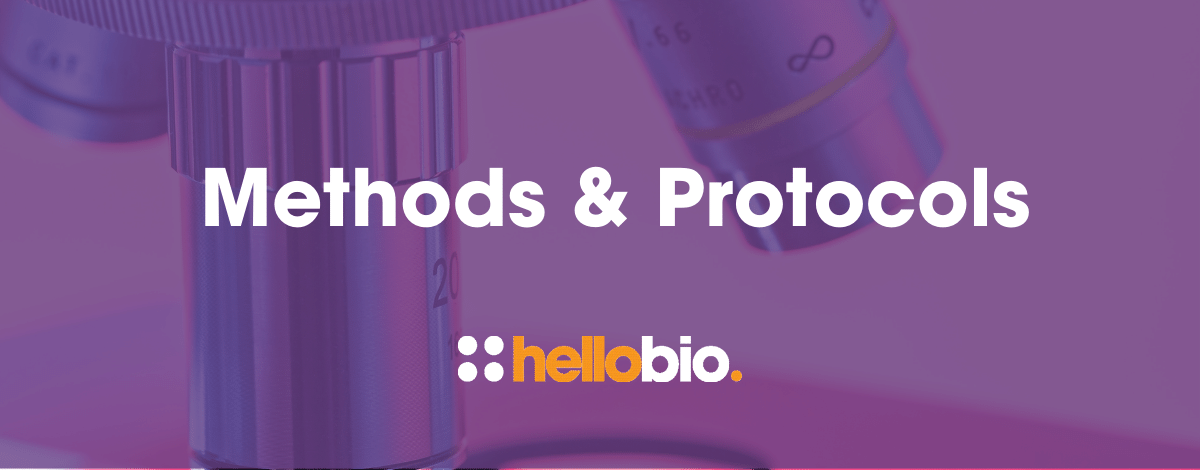Jeff Watkins - A chemist with enormous impact upon neurobiology
Jeff Watkins was born in Perth, Australia, in 1929 and sadly passed away at a village near Bristol, UK, in May 2023, at the ripe old age of 93. His contributions to neuroscience are unsurpassed. As described more fully in an obituary in Neuropharmacology (Collingridge et al, 2023); he is primarily responsible for establishing L-glutamate as the major neurotransmitter in the vertebrate CNS, for discovering the NMDA receptor and its block by magnesium ions, for establishing the three major ionotropic glutamate receptor subtypes (AMPA, Kainate and NMDA) as well as being an early pioneer in the discovery of the metabotropic glutamate receptor family.
But Jeff’s impact went beyond these amazing accomplishments that underpin our understanding of the human brain in Health and Disease. He produced some of the most valuable reagents for investigating the CNS, and this also led to the birth of a number of chemical reagents companies in the Bristol area, including Hello Bio! When he ran a small academic research lab in the Department of Pharmacology at the University of Bristol he regularly gave out samples of his reagents that he had designed and synthesised. But soon demand far exceeded what he could produce in his lab. He therefore took the bold step to retire from his academic position to be the founder of a chemical synthesis company, called Tocris Neuramin, in 1982. Following management buyouts and acquisitions, this company later became Tocris Bioscience. Steve Roome, who worked with Jeff during his time at Tocris, went on to found both Ascent Scientific and Hello Bio – two chemical manufacturing companies that embodied the original Watkins values of making innovative chemical tools affordable and easily accessible to the research community.
So what biologically significant compounds did Jeff Watkins produce?
Most famously Jeff synthesised N-methyl-D-aspartate, a highly specific ligand for one of the ionotropic glutamate receptors that he named the NMDA receptor. He also discovered HA-966 which he showed to be an NMDA receptor antagonist and was later found to be a partial agonist that binds to the glycine site of the NMDA receptor. In parallel with Hugh McLennan (Vancouver, Canada) he went on discover how to design competitive antagonists for the NMDA receptor and he produced a large series of selective NMDA receptor antagonists, including D-⍺-aminoadipate, D-CPP, D-CPPene and, most famously, D-AP5 (D-APV). With his collaborators he used D-⍺-AA to firmly establish that L-glutamate is an excitatory neurotransmitter. He also designed and synthesised some antagonists, such as y-D-glutamylglycine, that act on additional ionotropic glutamate receptors (termed non-NMDA at the time) and used these together with D-⍺-AA to demonstrate that both NMDA receptors and non-NMDA receptors mediate synaptic transmission in the CNS.
A privilege to be part of his team
“I was a postdoctoral fellow in Jeff’s lab from 1986-1999 working as a synthetic organic chemist. I learned so much from Jeff during that time, including an understanding of the pharmacology and medicinal chemistry of glutamate receptors. It was a privilege to be part of the team that discovered some of the first selective agonists and antagonists of metabotropic glutamate receptors. When Jeff retired in 1999 I took over running the research group. Much of what we did subsequently on developing novel subtype selective antagonists for NMDA and kainate receptors had roots in the work I did with Jeff. It was Jeff’s idea that I should use computer aided drug design as a tool in new compound development. The later advances in structural determination of glutamate receptor 3D structures allowed me to take advantage of the modelling experience I gained in Jeff’s group. I will be forever grateful for his advice and encouragement.” - David Jane, Emeritus Professor of Chemical Pharmacology, University of Bristol
D-AP5 soon superseded D-⍺-AA and has been used extensively to establish multiple physiological functions and pathophysiological roles of NMDARs. For example, Jeff’s D-AP5 was used to discover the roles of NMDARs in synaptic plasticity (initially long-term potentiation (LTP) but then a role in long-term depression (LTD) was also discovered). It was also used to establish the concept of dual component synaptic responses comprising separate non-NMDA (now called AMPA) and NMDA receptor components. D-AP5 is still the most widely used NMDA receptor antagonist - a recent Pubmed search for “D-AP5 or D-APV” returned ~4,500 hits.
A huge influence on my scientific career
“By introducing me to the field of glutamate receptors Jeff was a huge influence in my scientific career. He gifted the NMDA and D-AP5 which I used to discover the role of NMDA receptors in LTP. Collaborating with Jeff, we showed that mGluRs are also important in LTP and LTD - work only possible due to the MCPG that he and David Jane developed.” - Professor Graham Collingridge CBE, FRS
Jeff made compounds that have helped distinguish the non-NMDA receptors into what are now termed AMPA and kainate receptors. These include the agonists 5-fluorowillardiine, 5-iodowillardiine and 5-bromowillardiine and the antagonist pCB-PzDA which preferentially target AMPA and kainate receptors.
He also helped identify L-AP3 as an antagonist and L-AP4 as an agonist at metabotropic glutamate receptors (mGuRs) and went on to design and synthesise a large range of mGluR antagonists. Most famously MCPG, which was used to establish roles of mGluRs in synaptic plasticity and metaplasticity. Other derivatives such as MCCG, EGLU, MAP4 and CPPG targeted different mGluR subtypes and helped establish the roles of these in a variety of physiological and pathophysiological functions.
Outstanding achievements & an inspirational legacy
“Shortly after arriving in the UK I tested, in a blinded manner, a range of Jeff’s newly synthesized mGluR ligands. One compound was extremely interesting in that it blocked the induction of LTP. This compound, that Jeff called MCPG, formed the basis of a paper published with Jeff in Nature in 1993. Using MCPG my colleagues and I went on to identify roles of mGluRs in LTD and a form of metaplasticity. These studies were so influential for my career.” - Zuner Bortolotto, Senior Lecturer in Neuroscience, Bristol University
Many of glutamate receptor ligands that Jeff first synthesised in Bristol decades ago, are still manufactured today in Hello Bio’s Bristol-based labs and are used by thousands of scientists worldwide to further progress vital neuroscience research.
“Jeff’s legacy goes far beyond his research accomplishments. His early entrepreneurial career saw him found a company to provide research tools to his colleagues, and that is where I first met him. This set in motion the events that led to the evolution of Hello Bio – a company that continues Jeff’s ethos of making research tools easily accessible and affordable to researchers all over the globe.” - Steve Roome, PhD, Hello Bio Founder
More information
- The Glutamate Story - https://www.ncbi.nlm.nih.gov/pmc/articles/PMC1760733/
- Metabotropic glutamate receptor ligands
- Ionotropic glutamate receptor ligands
About the authors
Graham Collingridge is the Director of the Tanz Centre for Research in Neurodegenerative Diseases (CRND), Krembil Family Chair in Alzheimer’s Research, Professor of Physiology, Department of Physiology, University of Toronto and a Senior Investigator at the Lunenfeld-Tanenbuam Research Institute at Mount Sinai Hospital, Toronto, Canada. He is a former president of the British Neuroscience Association and Canadian Physiological Society. He is a co-winner of The Brain Prize 2016 and was awarded a CBE in the 2019 Queen’s Birthday Honours. He uses pharmacological tools combined with genetics, electrophysiology and imaging to study the molecular basis of synaptic plasticity in health and disease. Connect with Graham on LinkedIn: Graham Collingridge
David Jane is an Emeritus Professor of Chemical Pharmacology at the University of Bristol. His research involved developing pharmacological tools for AMPA, Kainate, NMDA and mGlu receptors, with expertise in ligand and structure based design of novel glutamate receptor agonists, antagonists and allosteric modulators, chemical synthesis of target compounds and pharmacological characterisation of novel compounds.
Zuner A Bortolotto was a Senior Lecturer in Neuroscience until recently and now has a Honorary position at the University of Bristol. His research focuses on synaptic plasticity, LTP and LTD. Connect with Zuner on LinkedIn: Zuner A Bortolotto
_________________________________________________
If you enjoyed this article, why not check out the other resources available on our blog. We are passionate about supporting life scientists including early career life scientists and PhD students - with really low-priced reagents, antibodies and biochemicals, early career scientist grants, and resources to help with both personal and professional development. We know how tough it is - so we hope you find these helpful!
More General Support for Life Scientists
For advice on wellbeing, dissertations, presenting at conferences, wellbeing, PhD support, networking and lots more, we have a huge range of articles to help - just click below:
Save up to 50% on our high purity reagents...
When you get to the stage of planning your experiments, don't forget that we offer a range of low-cost, high-purity agonists, antagonists, inhibitors, activators, antibodies and fluorescent tools (yes - they really are around half the price of other suppliers!) You can use our Quick Multi-Search Tool to search for lots of products in one go, and the range includes:
- Enzyme inhibitors and activators
- Chemogenetic ligands
- Ion channel modulators
- GPCR & ionotropic receptor ligands
- Cell biology reagents & biochemicals
Technical resources
Try our Molarity Calculator: a quick and easy way to calculate the mass, volume or concentration required for making a solution.
Try our Dilution Calculator: an easy way to work out how to dilute stock solutions of known concentrations
We also offer a comprehensive range of technical resources including antibody protocols and methods, product guides and mini-reviews:
And finally, don't forget to check back in with our blog regularly for our latest articles. If there’s something you’d love to contribute to the community, whether that’s an interview or article, drop us a line at hello@hellobio.com
---





